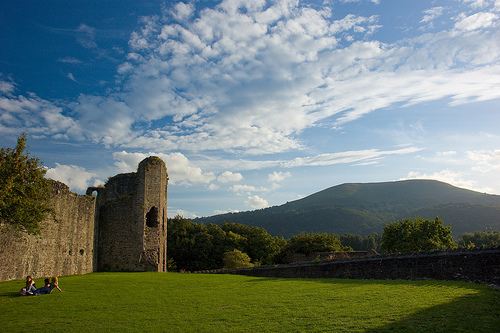

Location: Aberregavenny, Monmouthshire Map
Abergavenny Castle is a ruined castle in Monmouthshire, Wales. Classified as a Grade I cultural monument and protected as a Scheduled Monument, the ruin lies south of Abergavenny town centre.
Around 1090 the Norman conqueror Hamelin de Ballon
established a moth as the center of the new Norman rule of
Abergavenny. In 1141 Hamelin's nephew Brian FitzCount gave the
castle to his cousin Miles de Gloucester. In 1166 Abergavenny fell
to William de Braose, who had married Bertha, daughter and heiress
of Miles de Gloucester. At Christmas 1175 the Abergavenny massacre
took place in the castle, during which the son of the same name,
William de Braose, had the Welsh prince Seisyll ap Dyfnwal and his
entourage massacred during a banquet. In 1182, in retaliation for
this crime, the Welsh lord of Caerleon Hywel ab Iorwerth, a cousin
of the slain, burned the castle down. During the reconstruction, de
Braose had the castle fortified with a stone curtain wall. After the
rebellion of de Braoses against King John, the castle fell to the
crown in 1208. In 1216 it was recaptured by Reginald de Braose, a
son of William, with the help of the Welsh prince Llywelyn ap
Iorwerth. After Reginald's son William was executed by Llywelyn ap
Iorwerth in 1230, his lands were divided among his daughters.
Abergavenny fell to Eva, who married William de Cantilupe in 1241.
During Richard Marshal's rebellion in 1233, the castle was destroyed
by Marshal and his ally, Llywelyn ap Iorwerth. In 1263 the castle
withstood a siege by Llywelyn ap Gruffydd under Peter de Montfort,
who managed the castle for the underage George de Cantilupe. After
the death of George de Cantilupe in 1273, his nephew John Hastings
inherited the castle. In 1389 the castle fell to William Beauchamp,
who had a new gatehouse built around 1400 to ward off the threat of
Owain Glyndŵr's rebellion as the last building measure on the
castle. The castle passed through succession to the Earls of Warwick
and finally to the Nevill family, whose head was made Earl in 1784
and Marquess of Abergavenny in 1876.
During the English Civil
War the castle was razed between 1645 and 1646 and then used as a
quarry. The 2nd Earl of Abergavenny built a hunting lodge for the
Earls of Abergavenny on the castle hill from 1818 to 1819. The
castle grounds were redesigned as a landscape garden, and the
northern section of the circular wall was demolished for this
purpose. The 1st Marquess of Abergavenny had the garden converted
into a public park towards the end of the 19th century.
The
park and the ruins of the castle are freely accessible today, the
former hunting lodge has served as the Abergavenny Museum since
1959.
The ruin sits on a hill above the River Usk. Access to
the castle was through the gatehouse on the north side of the castle,
which has a gatehouse and a long, narrow, originally arched passage.
Living quarters were located on the upper floors of the gatehouse.
Adjacent to the gatehouse are the ruins of the outer wall of the
13th-century dwelling hall, adjoining the hall on the west side is a
fully preserved section of the ring wall and the ruins of a round and a
semi-round tower from the late 13th century.
The hunting lodge
built in the 19th century on the medieval castle hill is a two-storey
rectangular building in neo-Gothic style with battlements and corner
turrets.